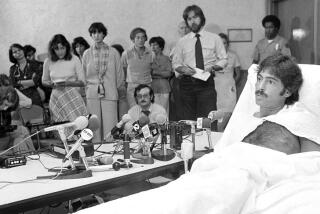Life After Synanon
In the turbulence of the late 1960s and early 1970s, when the Vietnam War was at its peak and faith and society’s institutions were becoming unmoored, a small drug and alcohol program in Santa Monica became an unlikely buoy in a storm.
Synanon had been heralded by Time magazine for its supposed 80% success rate and touted by a politician as “a man-made miracle on the beach.”
Its founder, a charismatic former drunk, may have been so intoxicated by fabulous press that he decided he could make the “miracle” apply to everyone. In 1969, Charles E. Dederich stopped graduating drunks and drug addicts to the larger society and instead invited the larger society to join his drunks and drug addicts in a Utopian quest to perfect communal life.
Thousands of disaffected middle-class “squares” (non-addicts) responded. Attracted by the compellingly brutal honesty that was common currency in Synanon, where onetime drug addicts would introduce themselves by saying, “I’m a dope fiend. What do you do?”, they enlisted in what became a cult.
Their children, some of whom are pictured here as young adults with their parents, were swept along on a journey that was to include heavy doses of hypocrisy. Separated from their parents and raised by other members of the community, they watched as the organization repeatedly redefined and ultimately betrayed itself.
Synanon’s two most inviolate principles were sobriety and nonviolence. But for a time in its later years the pacific community maintained a goon squad that beat up perceived enemies and, in its waning days in the mid-1980s, held happy hours where alcoholic beverages were served. In between, Synanon declared itself a religion in which an increasingly unbalanced Dederich composed what amounted to scriptures: Married members were required to divorce and recouple or leave, and men underwent vasectomies so that Synanon could give more priest-like care to the children of the world.
Among those who divorced were David and Janet Schwartz, both medical doctors and the parents of Deborah Schwartz, the 27-year-old L.A. photographer who took these pictures. Deborah was conscripted into Synanon as an infant when her parents, motivated by idealism, signed themselves up.
Five years later, at age 6, when she learned they were getting divorced, she recalls her reaction as “Oh....It didn’t change my life,” she says. Raised in Synanon compounds in Santa Monica, Marin County and the Sierra foothills, Deborah had not seen much of her parents, but says she never stopped missing them.
Synanon children--about 250 at the organization’s peak--were housed in their own dormitories, beginning at age 6 months, and nurtured communally by teachers, known as “demonstrators.” Some of them, the children say, were wonderful and caring, others were abusive ex-drug addicts and thieves.
One of Deborah’s most poignant childhood memories is of yearning for her parents after being disciplined by a demonstrator. “I would rock myself and say in a sing-song voice, ‘Mommy and Daddy, Mommy and Daddy . . . take me away.’ ”
The children did everything together. They were were bused to town a couple times a year to shop, drew the rest of their possessions from communal bins and, as young as age 4, participated in the community’s central ritual, The Game, an aggressive encounter group in which each player was “indicted” by another for a real or imagined failing and then verbally pummelled by all until coming clean.
Deborah remembers The Game as “a good way to learn to speak your mind” but “very confrontational and scary.”
Much about Synanon was scary. Rule-breakers were humiliated. “Your head was shaved and you were told to shut up and made to wear a cardboard sign around your neck that said something degrading like, ‘I am an idiot.’ ”
Those who left were written off--”treated as dead.”
Many left anyway. Estimates vary about how many people passed through--perhaps 15,000 to 20,000 over 20 years. But records indicate there were no more than 1,700 practicing members at a time.
When Deborah and her friends left one by one, mainly as teenagers in the mid-1980s, they entered an outside world they had been taught to fear.
Synanon’s very purpose had been to replace the nuclear family. But at age 13, Deborah found herself living in just such a family with her mother and her mother’s second husband, an ex-drug addict whom Janet had married during Synanon’s “changing partners” phase.
Adjustments were rocky for the young cultists. Personal honesty was something they had learned to count on in Synanon. Outside, they had to learn not to trust so freely and to lock their doors.
Forthrightness had also been prized. “I could yell at you and say, ‘You’re an asshole . . . ‘ and afterward it would be OK,” Deborah recalls. In the outside world, one had to learn to be less direct.
In time, tempered periodically by tough love, the children made their way. The young adults in the accompanying photographs are marketing directors, entrepreneurs, construction workers and craftspeople. One is a parent; another an ex-drug user housebound battling AIDS.
All seem capable of an exceptionally high degree of detachment as they examine their own and their parents’ lives. Some remain angry about having been put through Synanon. Others are grateful. And still others, like Deborah, are focused on a question she knows she will never be able to answer satisfactorily. As she puts it: If not for Synanon, “what kind of person would I have been?”
More to Read
Sign up for Essential California
The most important California stories and recommendations in your inbox every morning.
You may occasionally receive promotional content from the Los Angeles Times.










